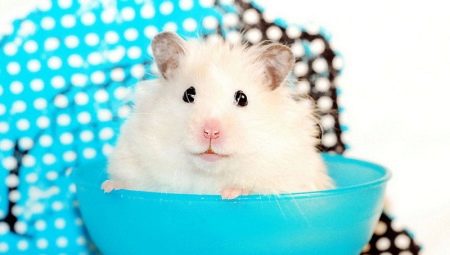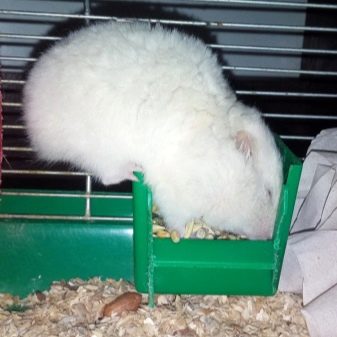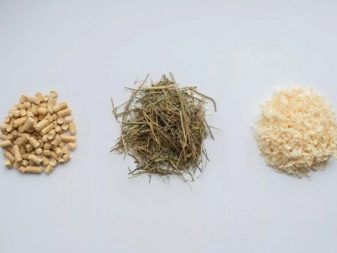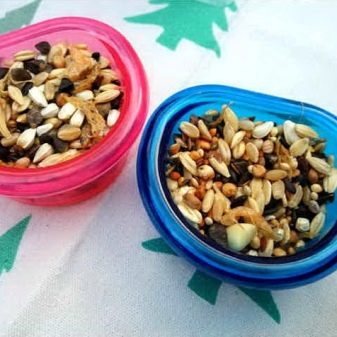All about white hamsters

All pets require attention and care. There are animals that do not cause much trouble and, if handled correctly, will delight their owners for a long time, for example, hamsters. They come in different breeds, and white hamsters with red eyes can delight exotic lovers.

Albino hamster - what kind of animal?
Wildlife is not very suitable for a snow-white hamster - an albino is vulnerable to predators. For breeders and breeders, this feature is of great interest. The coat and skin of albinos are devoid of coloring pigments. Due to the mutation, the color of the eyes of the animals is red: a network of blood vessels is visible through the transparent iris (there is no melanin in it).

The mutation is not a disease, but it increases the predisposition of albinos to stress. High-quality feeding, care and timely access to veterinarians are the key to a long life of a pet.
Views
Albino hamsters are not a separate species, but they can be of any breed. The most common ones are described below.
- Dzungarian hamster. His homeland is the steppes of the South-West of Russia. Unpretentious and friendly individuals are ideal for home keeping, they belong to the most popular breed for breeders with children. With careful handling, they do not show aggression, they quickly get used to the owners, they are able to recognize them. However, they can show aggression towards neighbors in the cage. Most active in the evening and at night.
They quickly explore the territory, stock up on food, willingly participate in entertainment (play and run a lot in the wheel). Monosaccharides are harmful to them because of the risk of diabetes. On average, they live about 3 years.

- Hamster "Campbell". It is a dwarf upholstered hamster native to the steppes of East and Central Asia.Its life span can be up to 2 years. Albinos "Campbell" are distinguished by increased aggressiveness and often bite the owners, sometimes you can approach them only with leather gloves. They are unpretentious in keeping, suitable for breeders without small children.

- Siberian (white Russian dwarf) hamster. Sociable representatives of the breed easily find a common language with children. Their body length reaches only 10 cm. They are silent animals, easy to train.
Due to increased activity, this individual requires a spacious cage with entertainment devices. With good care, a domestic Siberian white hamster can live up to 4 years.

- Syrian hamster. Widespread companion animals of this breed live from 2 to 4 years, grow up to 15 cm. Obedient, easily tamed individuals. They only get along poorly with each other: even if there are no signs of aggression, the animals experience stress when they do not live separately. They are social albinos - they require daily communication and become completely tame.

- Another interesting but rare breed is hamster "Roborovsky". They are incredibly fast moving individuals, social and very active. Their homeland is China and Mongolia. The smallest variety of albino hamsters is characterized by a body length of 5 cm. The breeder will need a cage with frequent twigs and increased attention.
Roborovskiy's hamsters get along well not only with their owners, but also with each other.

How to contain?
Mutations can make white hamsters with red eyes prone to skin problems. Scab, lichen, papillomas, dermatophytosis are common ailments, the course and treatment of which should be monitored by a veterinarian.
Unusual eyes can become a weak point - an albino cannot be kept in direct sunlight in order to avoid blindness, eye diseases and damage to the retina. The skin of white hamsters is also vulnerable - even furry individuals are not immune to minor burns and should be able to shelter from the sun and bright light. The hamster's cage should be located away from heaters and in an area protected from drafts, but with good air circulation.


The snow-white albino wool requires special care. At the pet store, you can buy sand that is suitable for baths. Water and sand must be provided to the animal - it is not recommended to bathe them on your own, since a healthy animal is able to take care of its cleanliness.
Albinos need solid food to grind their teeth, which grow throughout their lives. You can buy special mineral stones. If the owner is confident in his skills, he can trim the claws of the hamsters on his own. They are also devoid of pigments and have a light color, so the procedure should be carried out with extreme caution.


What should the house be like?
The albino cage is the place in which he will spend most of his life. She, like a person's dwelling, should be divided into sectors. In his home, an albino will eat, retire and rest, go to the toilet and be active.

Litter
The fairly common option of using newspapers and other paper is undesirable. Albinos tend to taste the surrounding objects "to the teeth", and ink will not be useful to them.
At the same time, white hamsters with red eyes can be allergic to wood dust, so the option with clean and soft wipes without dyes can be a way out. Hay works well for bedding, which some hamsters even make their own treat.


A common and convenient option is sawdust (it is important to ensure that there are no sharp chips and debris in them). They are not only not harmful to the albino, but also absorb moisture and odors. Cleanliness in the cage is important, first of all, for the pet itself.Wood filler is one of the most popular and sustainable options - it keeps odors for up to two weeks.
Convenient but expensive material - corn filler. It absorbs liquids as much as possible and retains its excellent appearance.
Various fibrous materials for bedding are contraindicated - most often they are cotton wool and fabrics. They can get into the albino's cheek pouches, start to rot and lead to inflammation. The threads are often wrapped around hamsters' paws - this can result in loss of limbs.


All litter changes as it gets dirty. The toilet is cleaned daily.
Different containers for food and water
To prevent the albino from overturning the bowl of water, you can purchase a special drinker that is attached to the bars of the cage. The owner of the animal needs to carefully monitor its serviceability and filling.
It is necessary to clean food and water containers without the use of chemicals - baking soda or tooth powder will do.


Items for activity
These include all kinds of running wheels, ladders and swings. Albinos are active at night. The less the owner has the ability to often walk the hamster, the more conditions for the release of energy must be provided in the cage. In this case, you need to ensure that so that the albino's paws do not get stuck between the bars or in the wheel.


It is essential that the cage does not remain open when it is at a height. In hamsters, not everything is perfect with spatial thinking - the animal can make an attempt to escape, not feel the distance to the floor and fall from a height.
Place to rest
Pet stores sell special houses in which hamsters equip a sleeping place with bedding. It is important to make sure that the hamster does not gnaw on the house or try to swallow pieces of plastic or metal. Many hamsters enjoy hanging out in hammocks.

What to feed?
The owner of an albino should not worry too much about his diet: the white hamster will eat the same as his relatives. Ready-made feed based on wheat, oats and other cereals, as well as sunflower and pumpkin seeds, corn, nuts, dried and fresh vegetables and fruits (carrots, beets, pears, raspberries, strawberries, zucchini peas, apples) are well suited. We must not forget about protein food - an albino will enjoy boiled (but not fried) chicken and fish, eggs and shrimps with pleasure.

Food is given twice a day in accordance with the weight and activity of the rodent - this must be observed and overeating should be excluded in order to avoid obesity. Hamsters can and should be given vitamins, buy them stones with minerals.
Albinos should not be given citrus fruits, spicy and exotic foods, garlic, sweets. White cabbage is especially harmful for them, onions, salt, mushrooms are contraindicated.

Small sizes do not save animals from big problems. If they occur (lethargy, suspicion of infection, hair loss, refusal to eat and water, inability to cope with the growth of teeth on our own) an urgent need to contact a veterinarian.

If you treat the maintenance of a hamster with full awareness of responsibility, he will keep company for as long as possible, delighting with activity and good mood.
For information on how to care for a hamster, see the next video.








